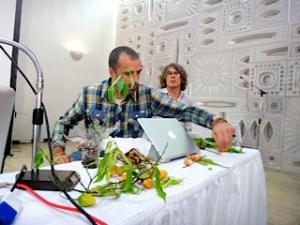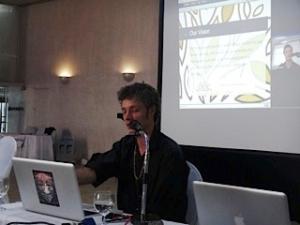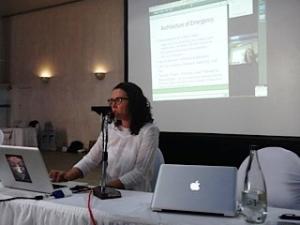special to Drug War Chronicle by Douglas Greene
Three dozen ibogaine providers, researchers and advocates gathered from May 7-10 in Durban, South Africa for the 4th International Ibogaine Provider's Conference, sponsored by the Global Ibogaine Therapist Alliance (GITA).

The last GITA conference was held in October 2012 in the harm reduction heaven of Vancouver, Canada. For this conference, GITA wanted to get back to the medicine's root -- iboga, a rainforest shrub native to West Central Africa that is sacred to practitioners of the Bwiti religion. After years of ibogaine's increasing popularity to treat Westerners with substance use disorders, iboga is under intense ecological pressure, and could be extinct in its native habitat of Gabon by late 2016, according to Yann Guignon, who wrote a report on the status of iboga for the Gabonese government in 2011-2012.
Guignon comes from an unusual background. He was born in France, but has been in Gabon since 2006, when he was initiated in the Dissumba branch of Bwiti. In 2007, France banned iboga after a death that had only an incidental connection to iboga.
Guignon gave the attendees a full report on the parlous state of the plant. "Over 90% of the iboga has disappeared from the country," Guignon said, and what it left is unaffordable -- the price of iboga has risen tenfold in less than decade. A bottle of 300 grams of medium quality root bark costs 100 euros (about $136), in a country where the 30% of the population that is employed has a minimum salary of 120 euros (about $163) per month.
There are also many factors endangering the supply of iboga: increasing land development and urbanization, the growing political and social power of evangelical Christians and climate change. As a result, "fake iboga" is now being marketed as iboga root bark and causing fatalities due to its cardiotoxic effects. And some Bwiti have started using alcohol instead of iboga in their ngenza (practice).
In response to these formidable threats to iboga's future, GITA and Guignon are taking action. GITA has proposed undertaking a collaborative effort with the Ethnobotanical Stewardship Council to launch the Iboga Dialogues, a multi-stakeholder engagement process to develop fair trade and safety standards for global use of iboga and ibogaine. Meanwhile, Guignon and his associate Jean-Nicolas Dénarié have started a few plantations on private land, and are in discussions with the Gabonese government to develop a plantation in one of Gabon's national parks, with the eventual goal of having a plantation in each of Gabon's 13 national parks.
Concerns about safety have been part and parcel of ibogaine's history as a drug detox. It's not just potent psychologically (about 75% of people treated experience intense personal and transpersonal visions -- not hallucinations, as often described in erroneous media reports). On a physiological level, it can produce bradycardia (a slow heartbeat) and/or arrhythmias (irregular heart rhythms). Last year alone, four of the 12 citations for ibogaine on the medical database PubMed were about deaths and toxicity. And rumors of deaths at clinics (as well as sexual assaults and thefts of intellectual property) have served to undermine the disorganized and reputationally disadvantaged ibogaine subculture.

According to Clare Wilkins, Director of Pangea Biomedics, this approach has several advantages over the standard practice of using a flood dose of ibogaine hydrochloride: it uses scarce iboga more efficiently, and allows for treatment of high-risk individuals who are normally excluded from ibogaine treatment. Most importantly, it allows clients to be conscious and gradually integrate the insights they glean about their substance use disorders into their awareness and daily practices.
Safety practices were also discussed by Kenneth Alper, MD, an associate professor of psychiatry at the NYU Langone Medical Center and Jeffrey Kamlet, M.D., FASAM, a Miami Beach-based specialist in addiction medicine, both during the conference and in a post-conference seminar devoted to provider discussion of treatment protocols and practices. Topics included patient electrolyte levels (the "number one problem in treatment" according to Kamlet), treatment of bradycardia and withdrawal from Suboxone, methadone and alcohol prior to treatment.
Although there's been an enormous amount of anecdotal evidence for ibogaine's efficacy, there has been a lot more popular media than medical articles about ibogaine (including a few stories after the death of actor Philip Seymour Hoffman and a major Al Jazeera piece that aired shortly after the conference). Consequently, most major drug policy reform organizations have remained silent on ibogaine. Even the Drug Policy Alliance, which honored Lotsof in 2009 just before his death with its Robert C. Randall Award for Achievement in the Field of Citizen Action, offers only a tepid endorsement of ibogaine research. ("Our take on ibogaine is that is shows interesting potential to assist some people in recovering from substance dependence. It should be more widely researched," says DPA harm reduction manager Meghan Ralston.)

Thomas Kinsgley Brown, PhD of the University of California, San Diego, reported on the preliminary results of the Mexico study. Data entry for the study was completed in April. According to Dr. Brown, "[i]n the first month, 11 of the [30] participants relapsed, another seven in the second month, one person in the third month, another four in months for through six, one person in the seven month and as many as five went all 12 months without relapsing."
These numbers may not be too impressive -- but as GITA's Development Director Jonathan Dickinson has pointed out, most ibogaine providers are using the drug as a detox, not as an ingredient in a comprehensive treatment plan. Dr. Brown also emphasized that six of the 30 participants had some continuing care in the first few months after ibogaine treatment, and suggested that it might be valuable to compare the ASI (Addiction Severity Index) subscores and/or months to relapse of the participants who received continuing care and those who did not. Factors that Dr. Brown suggested might be determinative of successful ibogaine treatment are a patient's drug use history, age, outlook and expectations of treatment, as well as the integration, type and suitability of fit of any continuing care they receive.
Although in an earlier stage of the study, the results in New Zealand tentatively appear to be promising, according to lead researcher Geoff Noller, PhD and Tanea Paterson, a substance use practitioner/ibogaine provider at Ibogaine Te Wai Pounamu (New Zealand's only current ibogaine treatment provider). The study enrolled its 14th and final subject in April. Seven of the participants were tracked for all 12 months of follow-up (as well as one who was lost to contact at 11 months), and of the six participants still being monitored, three (50%) remain opioid free. Noller and Paterson hypothesized that the differences between the results of the Mexico and the New Zealand studies could be attributed to (among other factors) ibogaine's status as a non-approved prescription medicine in New Zealand, which allows for an integrated system of care between physicians, pharmacists, ibogaine treatment providers and continuing care providers.
"In Durban we saw some important steps on a long road towards uniting the therapeutic and sacramental communities that use ibogaine and iboga. The important factor was outlining a sustainability dialogue that will affect both communities deeply, and I think beyond the practical function of planting trees this dialogue will have an evolutionary impact for everyone involved. What we have seen is that the situation we're facing with iboga's sustainability is grim, but that contained within it is a massive opportunity for cultural dialogue and healing. I believe that here we have been successful in initiating that," said Dickinson.
A conference report is available here. Ibogaine has a long way to go to achieve mainstream acceptance, and potentially safer ibogaine metabolites and analogs, such as noribogaine and 18-MC, are being aggressively developed. But as this conference demonstrated, there is a passionate, committed group of providers and researchers who are working globally to advance the states of the art and science of ibogaine practice.
Add new comment